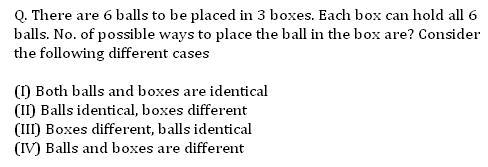
edit: (III) is balls differnt, boxes identical
Q2. There are 6 elements in a set A and 3 elements in a set B. Total no. of onto functions from set A to set B if a particular element of A is always associated with a particular element of B is ___
-
UP 0 DOWN 0 1 5

5 Answers
I) different ways are 6, 5+1, 4+2, 4+1+1, 3+3, 3+ 2+1, 2+2+2, whihc is 7 ways
II) boxes are different, then the number of ways is 6+30+30+6*5C2+6C2+6*5*4+6*5C3+6C3 ways
(Here, each term corresponds to on in I)
III) Think on similar lines as II
IV) 36
nishant sir,
isnt (II) simply x+y+z=6?
How to go about (III)? (had doubt only in that one)
nishant sir, perhaps u have missed the edit below the first question.. (II) and (III) in the diag are same.. its the (III) that im stuck with
btw can u check my answers for the other parts?
I = 7
II = 28
IV = 36 ?
asish.. the thing about 3...
edit: (III) is balls differnt, boxes identical
see the thing there is that you have to look at the 3 containers..
if the boxes are identical, then the only difference is that first take those distributions where you have
6+0+0... no of ways is 1
5+1+0... no of ways is 6
4+2+0 .. no of ways is 6C4 = 15
4+1+1... no of ways is 6C4 x 2 = 30
3+3+0 ... no of ways is 6C3/2 = 10
3+2+1.. no of ways is 6C3 x 3C2 = 60
2+2+2... no of ways is 6C2 x 4C2 x 2C2 / 3! = 15
now add these up.. unless i have missed out some case :)